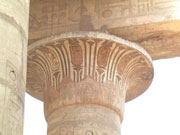TOUR NEWS - EGYPT NOVEMBER 2003
The November-December 2003 tour of Egypt was a new itinerary examining Middle Egypt and the Amarna period. The program explored monuments in the Fayum Oasis, the many and varied sites of Middle Egypt, and Luxor monuments dated to the Amarna period. The tour group consisted of ten participants: Ann and Ian Brown, Grant Hayes, Cameron and Michelle McLean, Dallas and Nareen Rolph, Hilde and Philip Rubie and Judy Wickert. The program was led by Michael Birrell with assistance by Amr Mohamed.
The group spent the first 5 days in Cairo, staying at the comfortable 3-star Pearl Hotel in the s outhern suburb of Maadi. From here we went to Saqqara where, apart from visiting the step pyramid of King Zoser, we had a chance to look around the tomb of the Amarna period General (later King) Horemhab. At Giza we went into the pyramid of King Menkaure and examined a number of private tombs of the Old Kingdom. Our lunch was in a restaurant at Giza with one of the most spectacular views in the world:

The November 2003 group at Giza: Grant, Michael, Hilde, Philip and Judy. Front row: Michelle, Cameron, Dallas, Nareen, Ann and Ian. © Michael Birrell
Two day-trips to the Fayum Oasis enabled us to experience this lesser visited part of Egypt. We saw the impressive ruins of the Roman town of Karanis and had lunch by Lake Qarun, and also saw the interesting Middle Kingdom pyramids at Lahun, Lisht and Hawara.
From Cairo we travelled south by train to Minya where we stayed 5 nights at the Cleopatra Hotel. The local authorities looked after us by providing an escort in the form of a small convoy of tourist police which caused much amusement among the group. From Minya we saw the spectacular ruins of the Roman town of Akoris, the town ruins of Hebenu with the small pyramid of Huni, and the beautiful painted tombs of Beni Hasan. Two days were then spent at the ruins of Amarna, where we explored the extensive town ruins and saw the vivid relief scenes in the private tombs of the high officials. The Royal Tomb is fascinating and preserves scenes of Akhenaten and Nefertiti mourning their daughter. A day was also spent in the Mallawi area, exploring the museum, ruins of Ashmunein, and Tuna el-Gebel with its painted tombs and galleries of mummified ibises.
A week was then spent in Luxor staying at the Gezira Hotel on the west bank. The group examined the remains of Luxor temple, Karnak temple, the 18th Dynasty tombs of the nobles (including Ramose and Kheruef) and the royal tombs of Ay and Tutankhamun. A visit to the ruins of Malkata, palace of Amenhotep III, brought some quizzical looks from the local tourist police who had never heard of the place! Everyone became archaeologists as we discovered blue painted pottery and fragments of painted plaster amongst the ruins.
From Luxor we had two day-trips, the first one to Abydos to see the temple of Sety I and the second to see the interesting and varied remains at the site of el-Kab. The high-light of the el-Kab trip was venturing into the desert to see the beautiful painted temple of Amenhotep III. On our return to Cairo we spent a day in the Museum looking at objects of the Amarna period. Our walk in the old quarter enabled us to see some of Cairo's superb medieval mosques including the Blue Mosque, a retreat from the heat and dust of Cairo.
Michael Birrell

